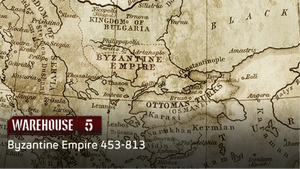| Warehouse 5 | |
|---|---|

| |
| Áποθήκη Πέντε | |
|
Location |
Istanbul, Turkey |
|
Host Nation Government |
Byzantine Empire |
|
City or Town |
Constantinople |
|
Years Active |
453CE - 813CE |
|
Status |
Deactivated |
|
Caretaker(s) |
Helios Kostopoulos |
|
Reason for Relocation |
Rise of Iconoclasm |
|
Previous Warehouse |
|
|
Subsequent Warehouse |
|
| [Source] | |
Warehouse 5 was the 5th incarnation of the Warehouse which was housed by the Byzantine Empire in Constantinople (modern day Istanbul, Turkey) from 453CE to 813CE.
It was inducted by Regent Helios Kostopoulos of Constantinople around 437CE and was finished sometime around 453CE.
Warehouse 5 officially came to an end sometime after the Rise of Iconoclasm around 813CE.
Location & Building[]
This Warehouse was built underneath the city of Constantinople (Istanbul).
Religion played a large role in the Warehouse's construction, design, and security. The Phos Hilaron hymn was required to open and close the Warehouse for the day; in addition to permitting access to the main entrance, it lit and extinguished all the candles and torches used throughout the Warehouse to illuminate it at the start and end of the day. Incidentally, its writer, Saint Athenogenes, also inspired the entrance's security system.
The entrance to Warehouse 5 was protected by a statue wielding a sword. When approached, the statue would incrementally raise its sword, which would ignite, in preparation to strike. To pause its progress, those wishing to enter must sing a song that expresses their personal faith (most often a hymn); only when the song was complete would the statue reset and allow access to the Warehouse.
List of main contributors to the building of Warehouse 5:
- Isidore of Miletus (Architect, Designing Underground Structures, Main Building, Technological Advancements)
- Leo I the Thracian (Emperor of the Western Roman Empire)
History[]
Once back inside the Roman Empire, the Warehouse once again begins to fill its shelves with artifacts from around the world. It lasted inside these borders until the rise of Islam and the Iconoclasm controversies, filling entire sections of the Warehouse with religious icons and paraphernalia. After the loss of most remaining Italian territories, the Warehouse moves once again - this time across the continents.

Sections[]
- Home of Light: This section housed the many candles, torches, etc. used to light the warehouse, as well as a series of mirrors that reflected light across the warehouse. Also this chamber housed a few artifacts relating to light.
- Dust Chamber: Warehouse 5 created this chamber to fill the warehouse with sand and rock to protect the artifacts in times of danger or immense emergency.
- Palace of Knowledge: This houses all records, documents, and the plans for renovation of the warehouse that soon disappeared. As well, it housed many tools, sculptures, and paintings.
- House of the Gods: This sector houses all religious artifacts, but not the clothes of religious icons.
- Chambers of Disarray: These rooms held only a few artifacts in each room. These rooms switch and move in a vast cavern separate from the main sections and work areas. Warehouse 5 used Hecate's torch and the thread from the loom of fate to find rooms they need to access.
- The Garment Storage: This area keeps garments, clothing, robes, and etc, mainly relating to religious icons.
Notable Artifacts[]
- Rose of Harpocrates: TBA
- Secundus the Silent's Stylus: TBA
Related Locations[]
- Sub Rosa Conclave: A secret chamber only a select few personnel, primarily Regents, were allowed access to. It functioned as a discreet meeting place where important Warehouse matters were discussed, such as the appointment of Caretakers. From the ceiling of the conclave, the Rose of Harpocrates was hung, ensuring that nothing discussed in that room could be mentioned outside its walls.
Notable Regents[]
- Helios Kostopoulos of Constantinople
- Takis Banis
- Elek Rigas
- Yin Jiangnu
- Stephanos Barbas
- Nicholas Athans
- Pygmalion Gabris
- Endymion Pallas
- Ieremias Kalivas
- Cetus Panagos
- Lotus Koskos
- Haemon Banis
Enemies/Adversaries[]
Affiliates[]
- Isidore of Miletus
- Leo I the Thracian
Events[]
PROCESSING
Technology[]
Due to many rumors of "light laser", Warehouse 5 decided to make their own. The agents later created the Home of Light, which held mirrors with torches that create spotlights. Mirrors were placed throughout the warehouse reflecting the candlelight. Only the Chambers of Disarray did not connect to this system of light but had separate torches. The Warehouse 4 plans were changed for a cat walk and architectural changes but the original Warehouse 5 plans somehow disappeared. For a security measure for the warehouse and to keep artifacts calm, many vents built into the walls of the cavern that had pocks filled with stones, pebbles, and sand were installed. With files from Warehouse 3 and stories passed down from Warehouse 2, the regents decided to do this and the activation was a statue of Salus that scanned the warehouse for evil intent and activated it. But for emergency burial, a series of hidden switches were put in place. After the warehouse left to the Khmer, the statue was lost while transport took place. After discussion the new plans for the warehouse were changed again. This time the basic area for artifact storage was changed to a series of rooms that changed and moved in a carved out cavern. The rooms contained a maximum of 6 artifacts and they moved and switched around in a cavern. When the security measure is activated the artifact that made the rooms move is neutralized and the rooms stop moving so the sand and rocks can fill in. When the rooms stopped moving, the chambers did not fuse into each other but fit perfectly to fill the large cavern that was carved out. The artifact that was used, was the serpent column and it to was lost with others on the transfer to Warehouse 6. Many thought the column had another power but, due to the way it was placed, it made rooms and chambers without bronze objects in them move. The downside of it is that the rooms can only move in a cavern or large hollow area. Many religious symbols were used to signify what the artifact did.(Ex: The crowned lily stands for St. Dymphna and represents mental illness.)
Reasoning For Shift[]
Rise of Iconoclasm[]
Warehouse 5 officially came to a close after the Rise of Iconoclasm around 813 AD.
| Warehouses |
|---|
| Warehouse 1 • Warehouse 2 • Warehouse 3 (Mayan Branch) • Warehouse 4 • Warehouse 5 • Warehouse 6 • Warehouse 7 • Warehouse 8 • Warehouse 9 • Warehouse 10 • Warehouse 11 • Warehouse 12 • Warehouse 13 |
